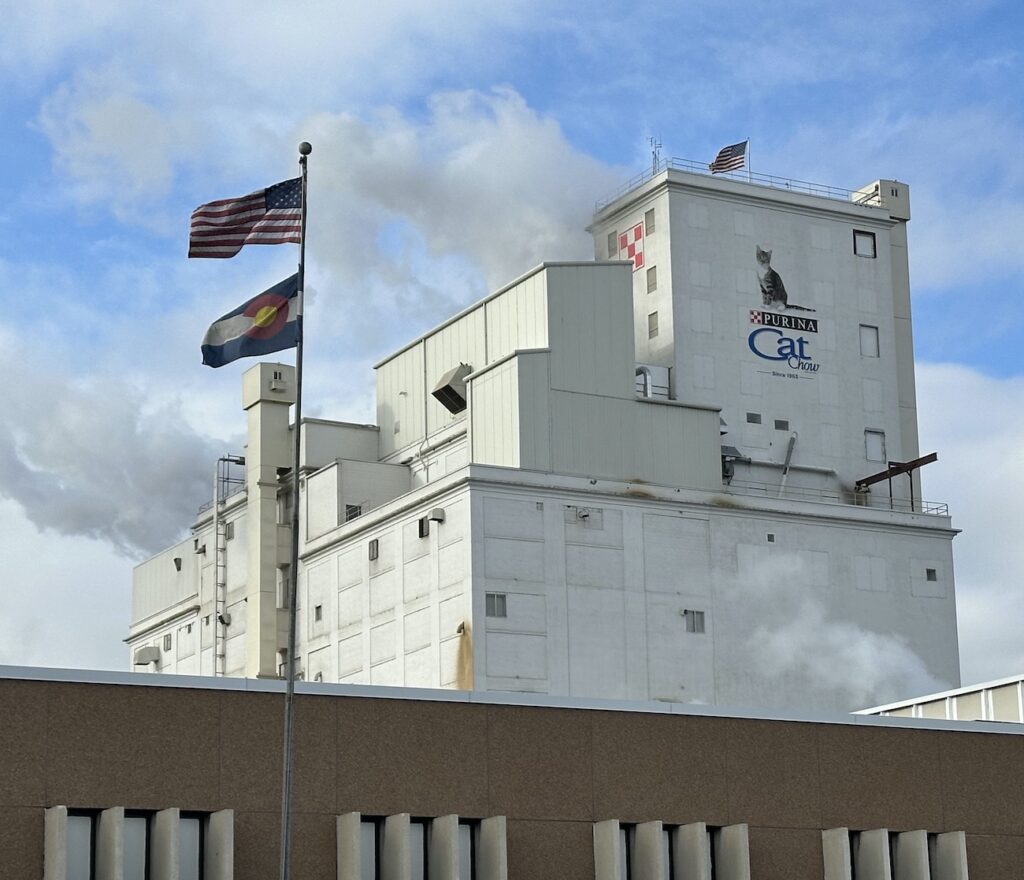By Trish Zornio
Check out City Cast Denver’s Feb. 22, 2024 interview with Trish Zornio after you’ve read this story.
North Denver residents have long complained about industrial odor pollution, particularly strong and foul odors emanating from the Purina pet food facility. Yet after a recent uptick in odor complaints in the latter half of 2023, the company has initiated new community discussions.
According to Denver Air Program Supervisor Bill Obermann, Purina representatives recently met with a handful of community residents at a December gathering facilitated by Denver’s Love My Air program staff. The results, he said, were encouraging.

“The reason for that [December] meeting was a long time in the making,” said Obermann, crediting Purina with reaching out to his staff for help in better collaborating with the community on odor concerns. At least one meeting participant agreed she was hopeful.
“I was very impressed with Love My Air and the industry for being willing to come to the room,” said Harmony Cummings of the Green House Connection Center, adding, “I wish they would pay the local residents to come and share their lived experience, because others in the room are paid, and financial compensation would allow more broad community participation.”
Still, Cummings and others expressed concerns about whether change from the facility was possible, and if state regulations on odors might be too lax given so many residents struggle with the pollution yet little has been done to stop it to date.
“We host a lot of events that bring folks to the facility, and many people are very shocked by the aroma in the community,” Cummings said. “Folks who live here, this is just how it is. This is just what it is. Locals don’t like it, but are so accustomed and helpless to it, so why keep trying?”
According to Obermann, to reach an odor violation requires a certified inspector to travel onsite and employ equipment that can dilute the air seven-fold. If the odor is still detectable after dilution, there may be a violation.
However, due to the inability to test immediately upon receiving an odor complaint, coupled with the difficulty of standardizing odor measurements, it’s rare for violations to be found. Obermann could cite only one odor violation by the Purina facility in recent memory. The incident was in 2021, and a fine of $12,000 was issued by the Colorado Department of Public Health and Environment.
A spokesperson for CDPHE confirmed the Colorado Air Pollution Control Division contracts the Denver Department of Public Health and Environment to conduct inspections and investigate air complaints in Denver, including odor complaints related to the Purina facility, according to the state’s seven-fold dilution standards.
Cummings also expressed concerns about the pet food manufacturer’s ability to truly understand the health impacts on locals.
“What we were told is that odors don’t have a health impact, only annoyance. But is that even true?” she asked. “What are the cumulative impacts [of odor]?”
The cumulative impacts of odor pollution have yet to be rigorously studied, however, odor pollution has been directly associated in many cases with negative public health impacts, according to multiple scientific studies and the Centers for Disease Control and Prevention’s Agency for Toxic Substances and Disease Registry.
Among the possible acute health effects of odor pollution listed on publicly available agency documents are headache, nausea, respiratory irritation, sore throat, coughing and depression. The agency also states that symptoms can vary by population, such as those diagnosed with asthma or chronic obstructive pulmonary disease (COPD), children and pregnant people being more likely to experience worse symptoms from odor pollution.
Scientific studies have also established correlations between odor pollution and subjective well-being, with odor annoyance specifically cited by one 2021 review as being “linked to stress, poor mental health, and decreased well-being.” High levels of odor annoyance were found to be most associated with negative quality of life.
University of Colorado professor Shelly Miller has published multiple studies on odor issues in Colorado and North Denver specifically. Her team also found a strong association between perceived odors and well-being in 2018, with a follow-up study in 2019 identifying the Purina facility as the most reported odor in North Denver.
Invitations to speak with facility representatives regarding odor concerns were met without a response.
“One of the things that came out of the chats with Love My Air and Purina was that the facility has been here for something like 90 years,” said Cummings. “We’ve grown with them and around them… we’re here now.”
Obermann confirmed he hoped this would be the first of many conversations, and he welcomed more community groups with concerns to join the table. He also noted residents can continue to file odor complaints through the city’s 311 program.
As for industrial odor solutions, the CDC offers a variety of recommendations such as the facility employing better tools to eliminate odors, community members creating odor diaries to track issues, odor release time restrictions, planting more greenery to help neutralize odors and better engaging with community members on when odors will be most severe so residents can leave or take precautions.

Be the first to comment